This is an online version of Shoes: Best Foot Forward, an exhibition that was on display at Newarke Houses, Leicester, from 30 September 2023 to 14 January 2024. This exhibition displayed a range of footwear including historical items and fashion footwear, from Leicester’s proud heritage as a leader in shoe making. Many of the objects in this exhibition were donated by the public and by local shoe companies.
Shoes that make their way into museum collections are often an eclectic mix reflecting what has survived or been kept. This means that the shoes held in museums are not always representative of everything that was worn at a specific time in history.
More women’s shoes from long ago survive than men’s shoes, maybe because women tended to have more pairs and as decorative items were passed down through the family.
Sometimes quirky or unusual shoes are kept as souvenirs and those which have had special meaning to people.
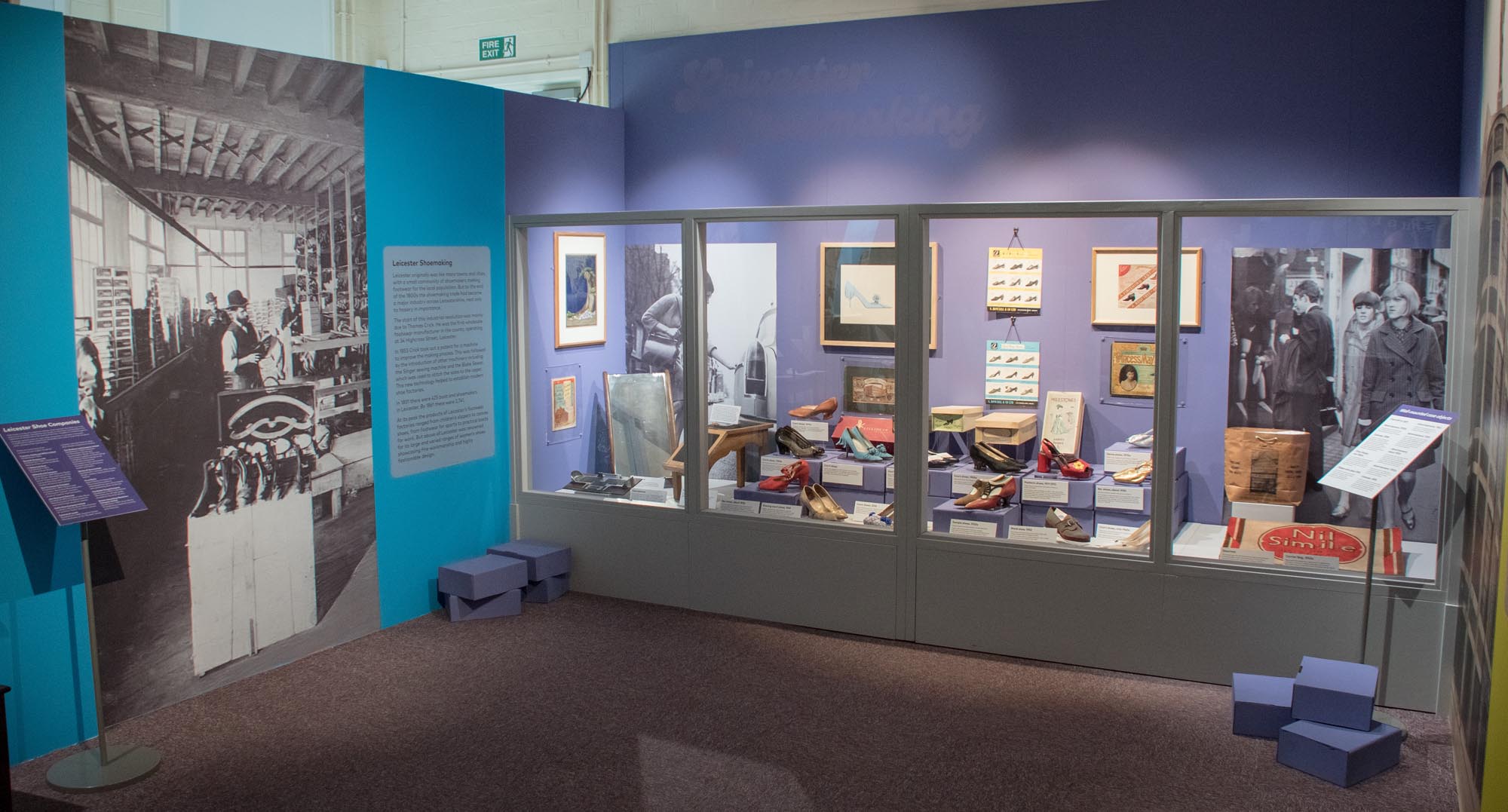
Shoes exhibition at Newarke Houses
Followers of Fashion
From early times shoes have been much more than just practical items of clothing. They can reflect our identity, be the height of fashion, or simply objects of wearable beauty.
Shoemakers and shoe designers have been creating wearable styles for hundreds of years. Inspiration for shoe designs can come from anywhere. They can also be influenced by the discovery of new materials like rubber or plastics. Changes in technology also change designs. For example, the invention of Velcro led to the creation of many new types of easy to fasten footwear.
These two cases contain a small chronological selection of shoes that shows some of the changes in heel height and shape, toe shape, fastenings and materials over the last four hundred years. Some styles have been in and out of fashion across centuries, and have changed very little. Women’s fashions follow a distinct pattern of high heels to no heels with changes in toe shape. This display also highlights how fashions were slower to change in the past, with some lasting over a hundred years like the passion for buckles. Today, fashions can change every month.

Various historical shoes on display in the exhibition
Shoe Superstitions
There are many superstitions associated with shoes. Some bring you good luck, others bad luck.
Here are some popular ones. Do you have a favourite shoe superstition?
- It is bad luck to put new shoes on a table causing a quarrel in the household, or at worst a death.
- The Lancashire custom of ‘smickling’ was performed by a woman wishing to conceive, she would try on the shoes of a friend who had recently given birth.
- A way of wishing somebody good luck on a journey was to throw an old shoe after them.
- The old boot tied to the back of the bride and groom’s car is a survival of the custom of throwing a shoe over the bride and groom to ensure that the marriage was successful with lots of children.
- A girl can find out who they’ll marry on Midsummer Eve if they place their shoes by the bed and chant: Point your shoes toward the street Leave your garters on your feet; put your stocking on your head, and you’ll dream of the man you’re going to wed.
- Norfolk girls would put a cloverleaf in their shoes in the belief they would marry the next single man they met.
- In Morocco if a man finds a slipper in the road, he’ll soon find a wife.
- You should put your right shoe on first. If you accidentally put the wrong shoe on you must take it off, go outside and have someone throw the shoe at you.
- If your shoes squeak it’s a sign that you haven’t paid the shoemaker.
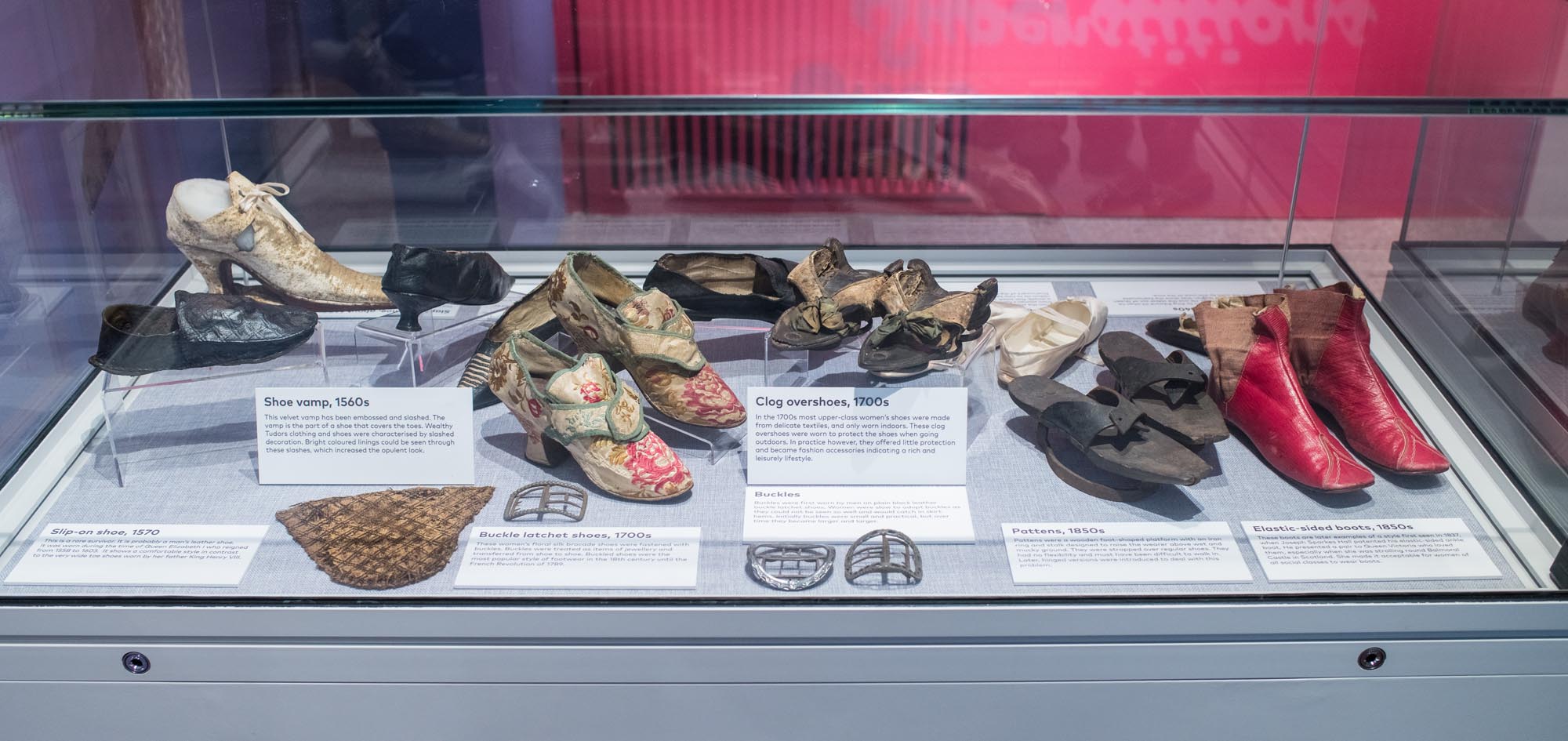
Shoes from the last 400 years on display
Hidden Shoes
Deliberately concealing shoes in a house is a common superstitious practice which dates from at least the Roman Period right up into the 20th century. Shoes have been found hidden up chimneys, within roof spaces and walls, and under floorboards in houses across Britain and Ireland, and in countries including North America and Australia. Finds can be one shoe, pairs of shoes, or multiple groupings. Shoes are also often found with other items such as bottles, bones, marbles and scraps of textile and newspaper.
Although a common practice, the reason why these shoes were hidden is open to interpretation. Nobody has yet to find anything written down at the time they were hidden to fully explain the practice. As a result, many reasons have been suggested.
It was thought that as these shoes tend to be highly worn, patched and repaired, and are clearly used personal items, that they were hidden to act as charms to protect the owner against evil influences or bad luck. The shoes could also have been thought to protect the house and its occupants from evil forces, with the evil spirits being either trapped in the shoe or repelled.
Other reasons suggested for hiding shoes in buildings include creating good luck, that they were hidden because they had been stolen, and that evil spirits didn’t like the smell of leather. Some have suggested that builders simply hid their rubbish at the end of a job, or just hid items as a way of saying “I was here” to future generations.
Why do you think shoes were secretly hidden?
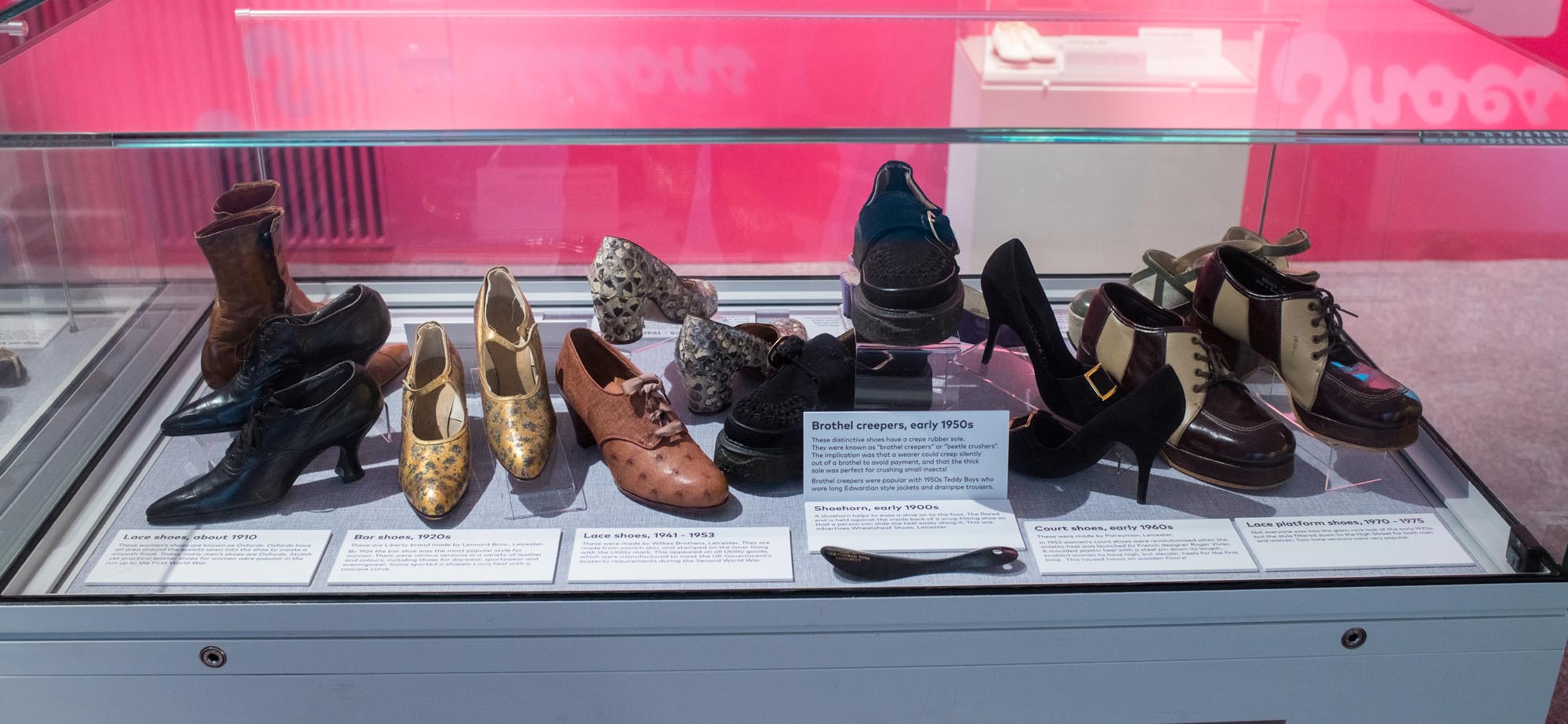
A selection on 20th Century shoes on display
Why We Wear Shoes
Shoes are very practical items of clothing. Early footwear was dependant on location. In hot countries, easily made sandals from local materials kept feet protected and cool. In cold climates, shoes made from animal skins kept feet protected and warm.
Since then, shoes have become powerful symbols. They can tell us about who we are, what we do, where we are from, what groups we belong to and how we want others to see us. They are very personal and emotional items. They can express our status, power, sexuality, wealth, identity, cultural and religious backgrounds and be a statement of personal expression.
We still choose shoes for very functional reasons. We might wear specific shoes at school, at work, in the military or for sports. We may need special shoes for performing or dancing. Sometimes these shoes are not what we would personally choose but they are the most suitable for the job or situation.
Shoes can also track our journeys through life. We wear them to celebrate special events and major milestones. We often keep these special shoes, filled with personal meaning and memories.
The shoes in this case from the museum’s collection reflect the variety of shoes we wear.
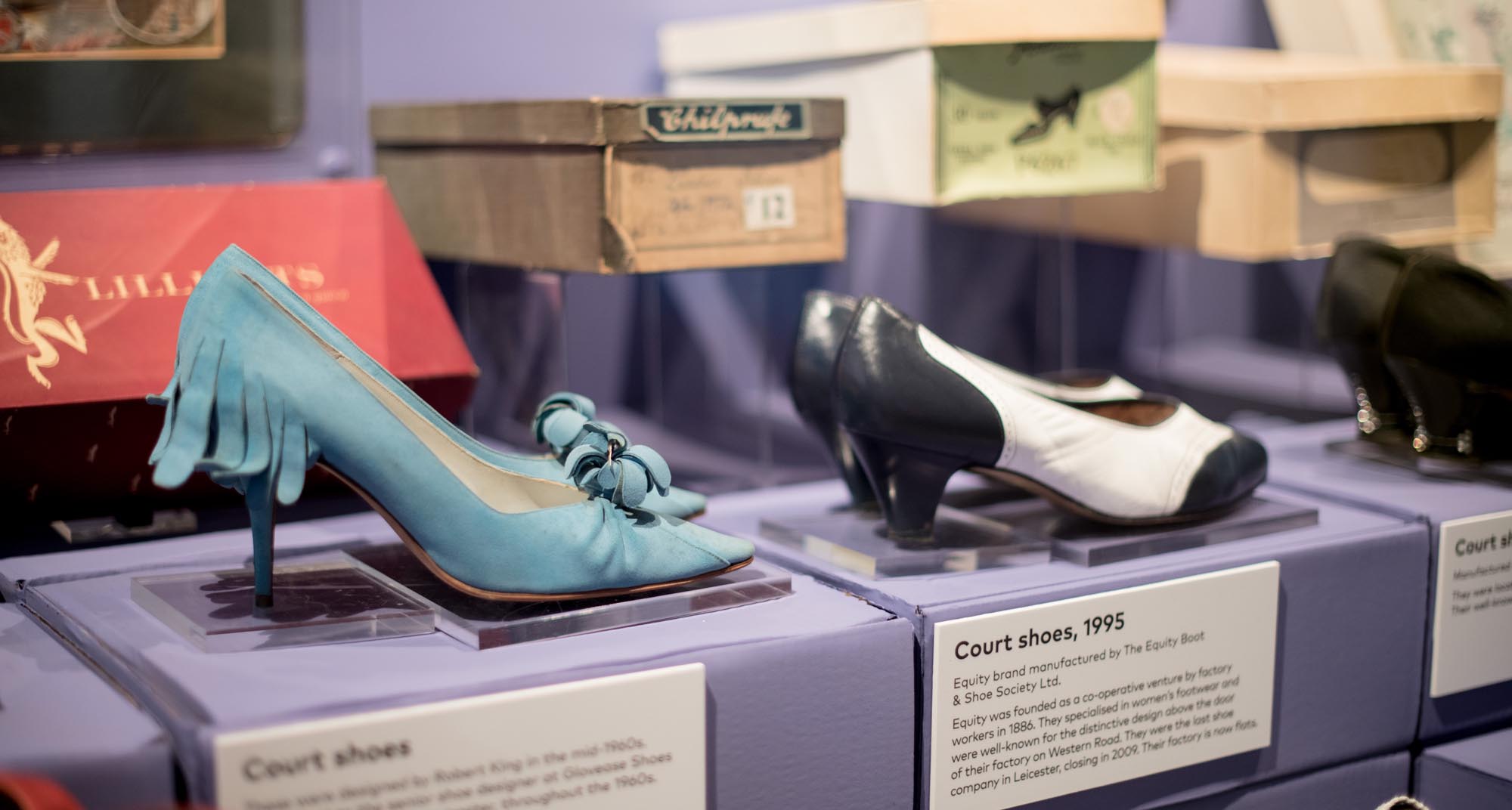
Leicester-made court shoes from mid and late 20th Century
Leicester Shoemaking
Leicester originally was like many towns and cities, with a small community of shoemakers making footwear for the local population. But by the end of the 1800s the shoemaking trade had become a major industry across Leicestershire, next only to hosiery in importance.
The start of this industrial revolution was mainly due to Thomas Crick. He was the first wholesale footwear manufacturer in the county, operating at 34 Highcross Street, Leicester.
In 1853 Crick took out a patent for a machine to improve the making process. This was followed by the introduction of other machinery including the Singer sewing machine and the Blake Sewer, which was used to stitch the soles to the upper. This new technology helped to establish modern shoe factories.
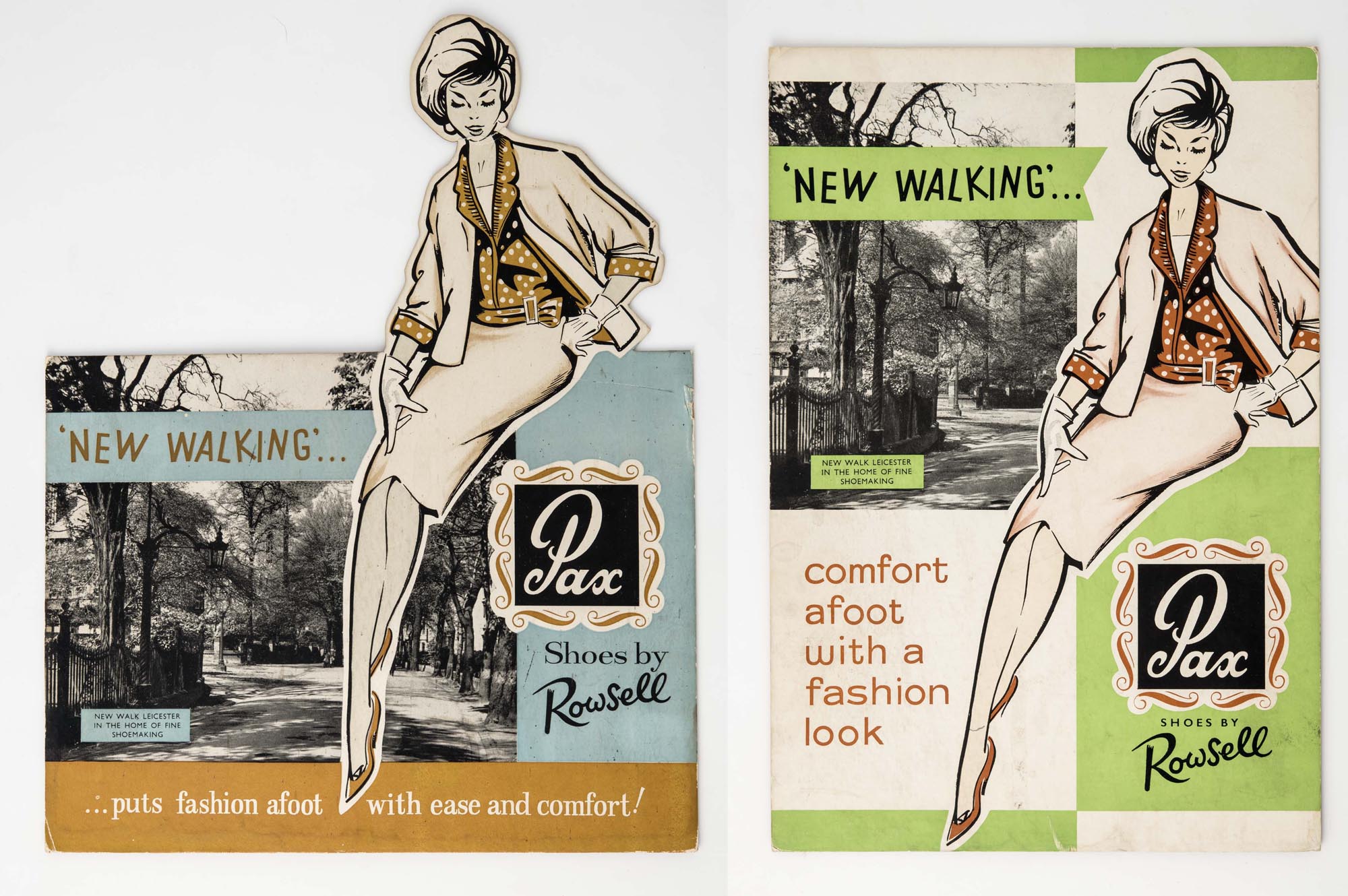
PAX advertising stands referencing Leicester’s New Walk
In 1831 there were 425 boot and shoemakers in Leicester. By 1861 there were 2,741.
At its peak the products of Leicester’s footwear factories ranged from children’s slippers to canvas shoes, from footwear for sports to practical boots for work. But above all Leicester was renowned for its large and varied ranges of women’s shoes showcasing fine workmanship and highly fashionable design.
Liberty Brand
Fredric Lennard and his five sons Samuel, Thomas, Henry, John and William built up a large shoemaking business in Leicester. In August 1901 they patented the Liberty brand of footwear. During the First World War they made boots for soldiers from their factory on Asylum Street (now Gateway Street).
Towards the end of the war two company directors travelled to New York to explore new ways of working, where they were impressed by the famous Statue of Liberty. On returning to Leicester in 1919 they had a smaller copy of the statue made, and placed it on the roof of their new factory on the corner of Eastern Boulevard and Walnut Street.
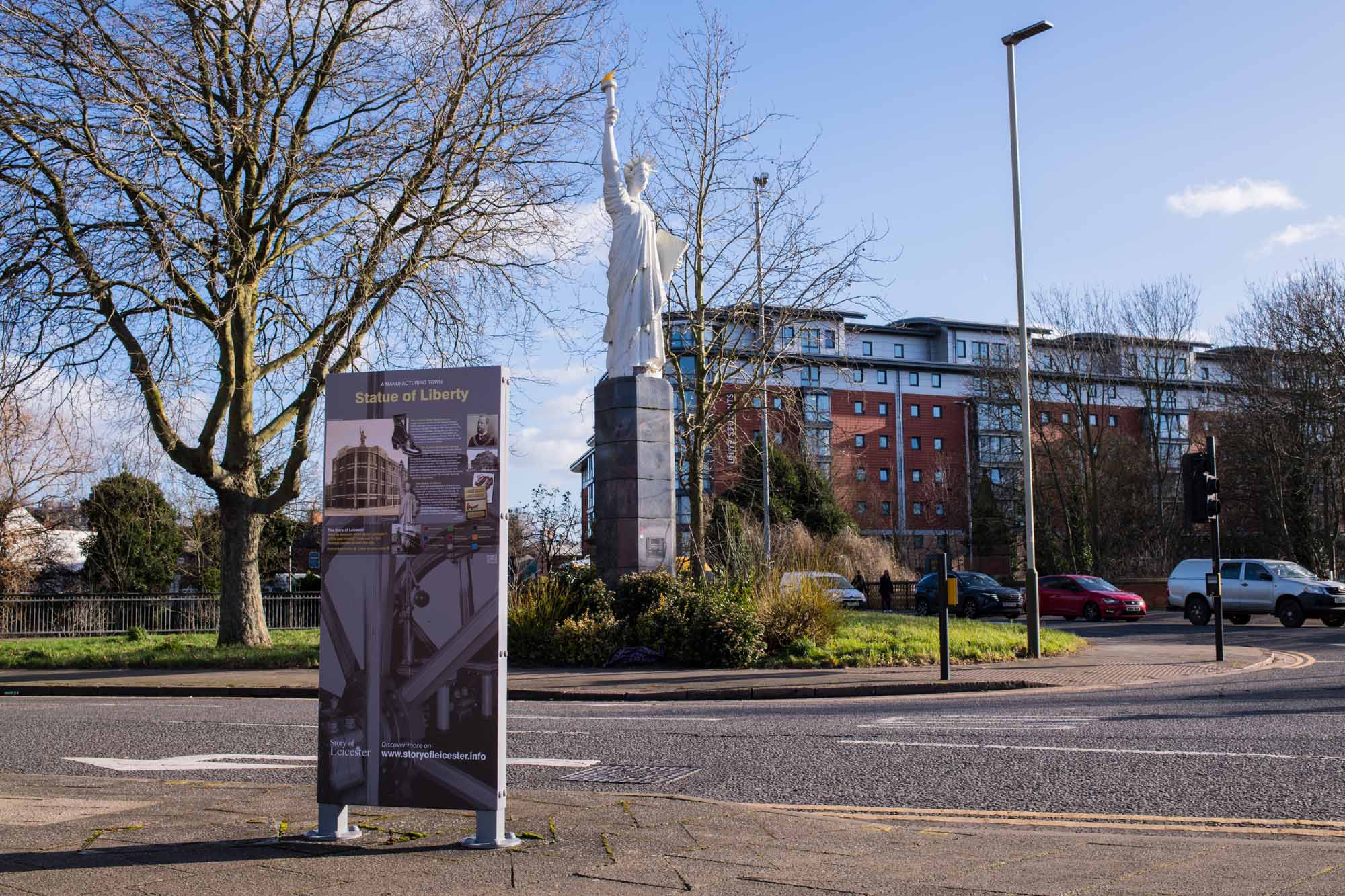
The Statue of Liberty that once topped the Liberty Factory, photographed in 2024
At its peak the Liberty Building factory manufactured over 15,000 pairs of women’s shoes a week. They were sold across the UK in Liberty’s own Public Benefit Boot Company shops. The Leicester shop was next to the Clock Tower.
Liberty Shoes were made in Leicester until 1973. The factory was demolished in 2003, but the statue was saved. In 2008 it was installed on the Swan Gyratory roundabout and is now a major Leicester landmark.
Equity Shoes
In 1886, the Leicester Co-operative Boot and Shoe Manufacturing Society was formed by workers from Leicester and Enderby. Co-operatives are owned and run by their employees or members. As the business grew, the Leicester Society moved in 1889 from their first factory in Friar’s Causeway to a larger factory in Belvoir Street. They moved again to Western Road in 1895.
The Society originally traded under the name of “Eagle”, but soon swapped to the “Equity” trademark.
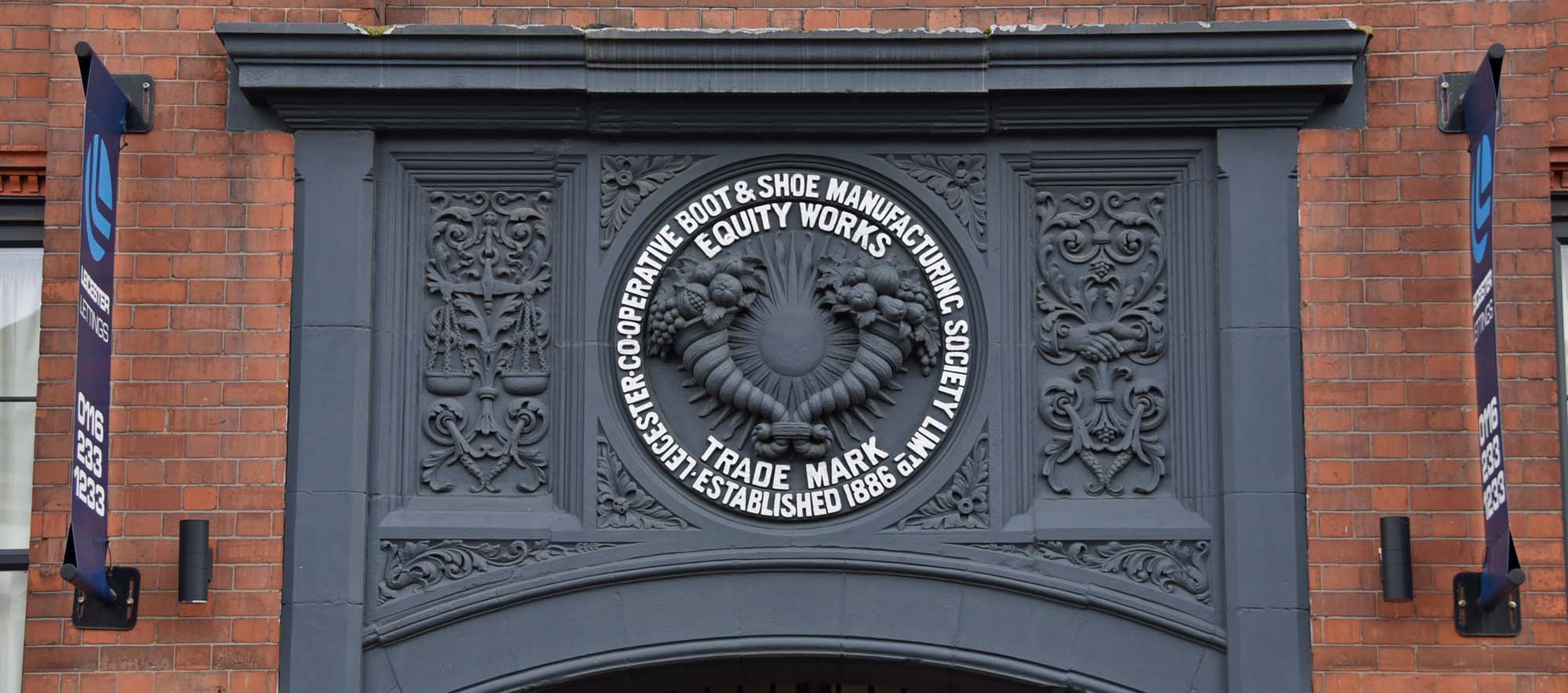
The entrance to the former Equity Shoes Factory on Western Road
Equity produced high quality women’s shoes. They earned a reputation for making some of the best wide-fit ladies’ shoes in the world.
Equity Shoes went into liquidation in January 2009. The company was bought by the York-based Pavers Shoes Ltd, who have maintained the Equity and Elmdale brands. The former Equity factory has been converted to residential apartments.
Frisby Shoes
Frisby’s was one of the earliest chains of boot and shoe shops to develop in England. Joseph Frisby set up as a dealer of boots and shoes in 1870 at 59 Belgrave Gate. He supplied the local population.
His business started to expand when he set up market stalls in several different market towns. Every Wednesday he traded from Powis Market Hall in Oswestry, while on Saturdays he manned a stall in the Cattle Market in Chesterfield.
As his business grew, he started to open shops. By 1905, the firm had over 80 branches in the Midlands, London, and the South. After the Second World War, however, increasing competition from overseas imports, changes in manufacturing, and the increasing popularity of wearing trainers had a big impact on Frisby’s fortunes.
The company remained a privately-owned family firm until 1982, when it had 156 outlets. In that year it was bought for £6 million by Ward White, which owned Tuf shoes and a chain named Wyles. Whites, and its brands, were in turn bought out by UK Safety in 1988.
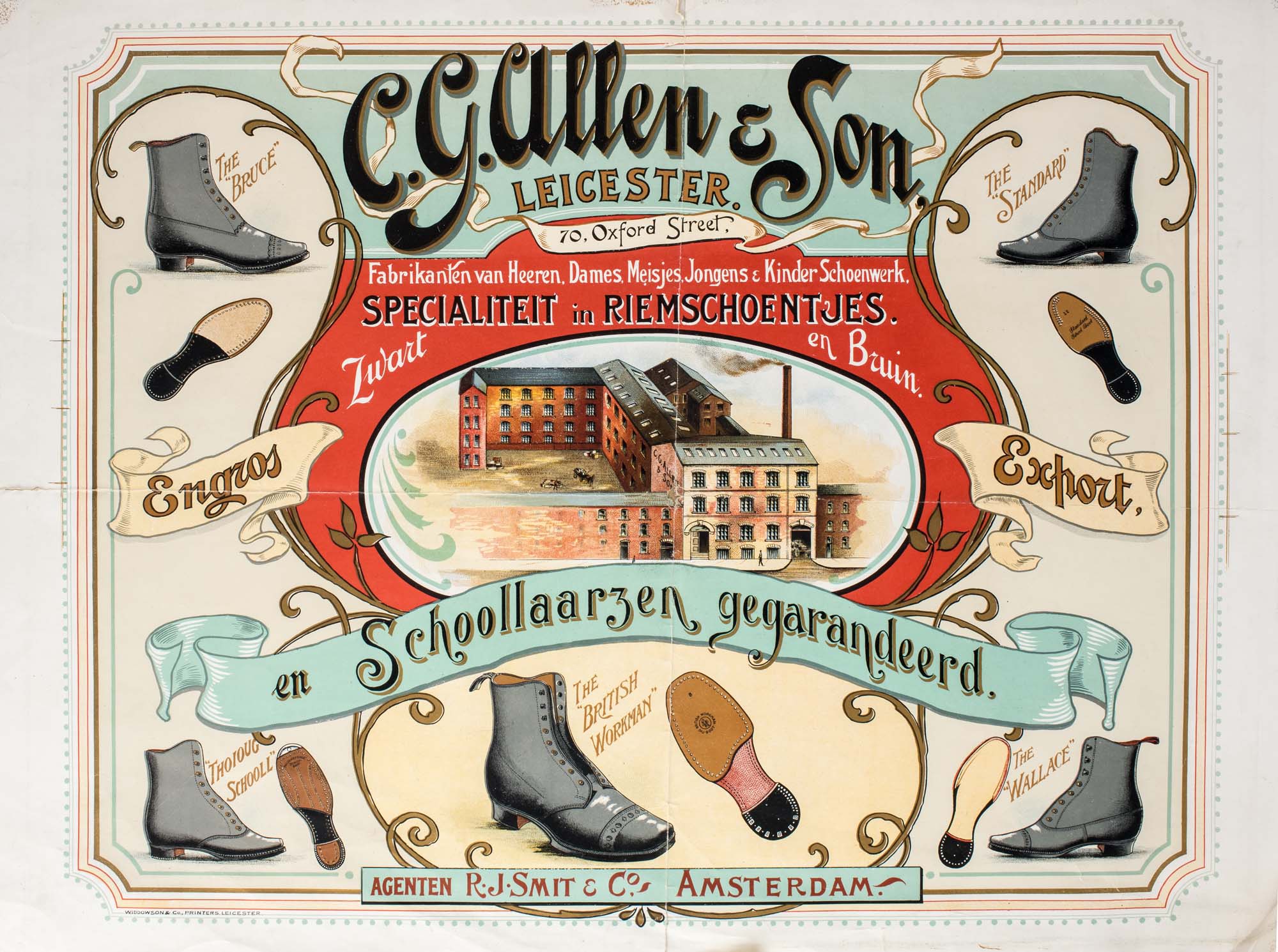
G.G. Allen & Son advertising poster, c.1910
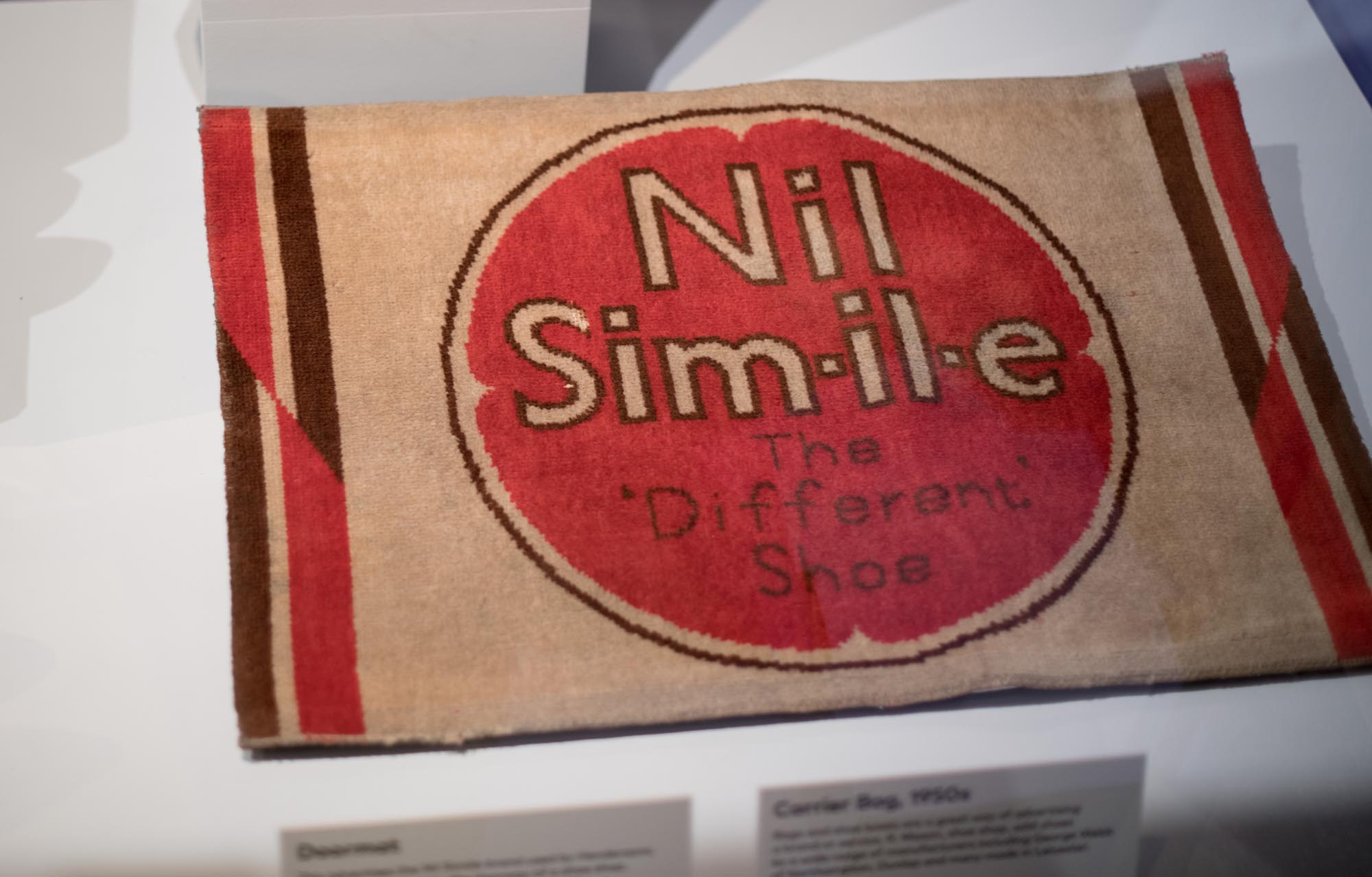
Nil Simile doormat advert. The Nil Simile brand was bought by Equity in 2000
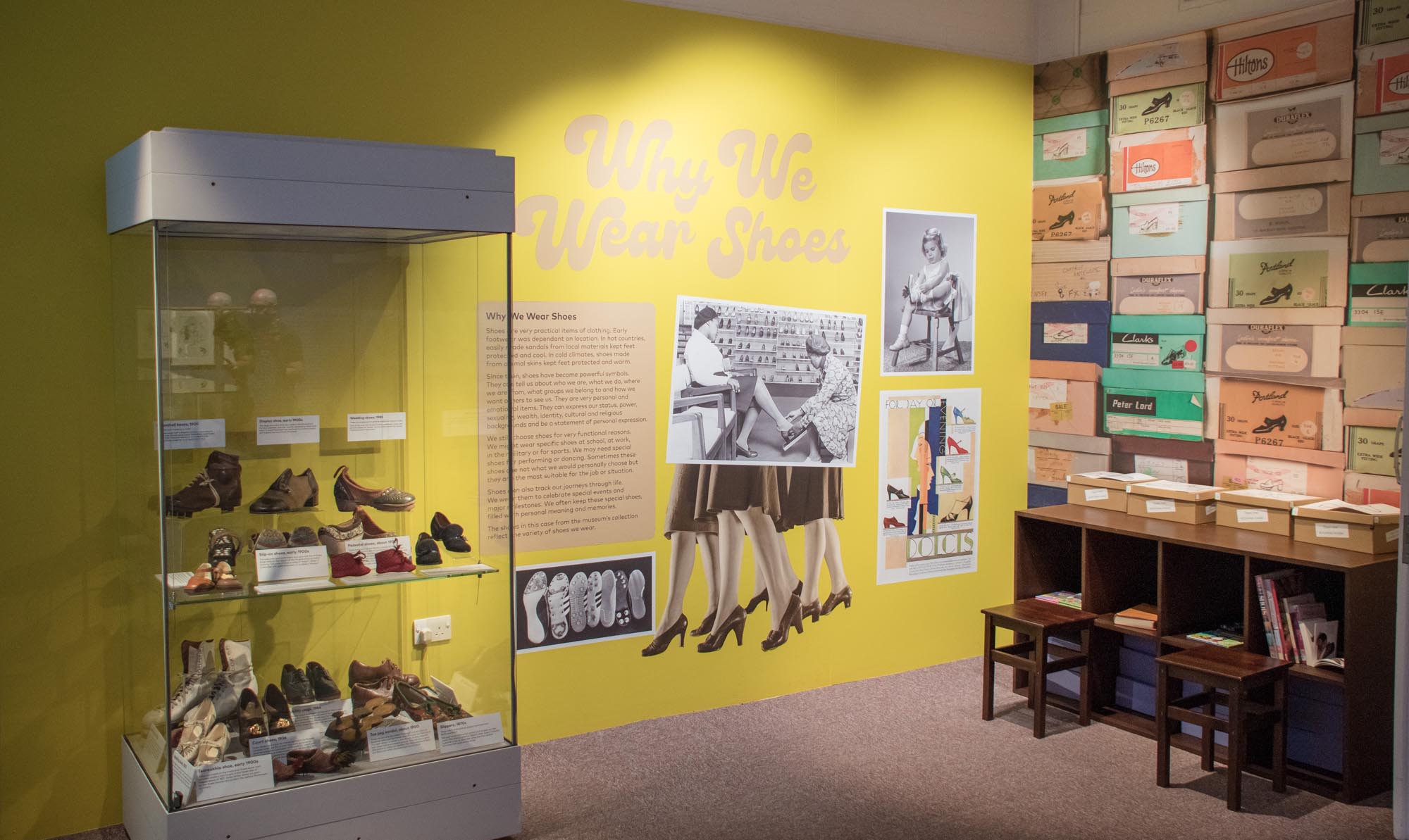
The Shoes exhibition at Newarke Houses

Shoehorn from Wheatsheaf Shoes, Leicester, early 1900s

Various shoe boxes from Leicester companies

